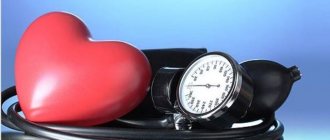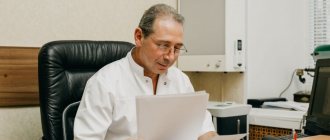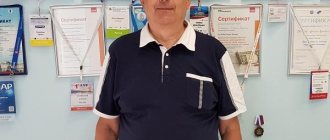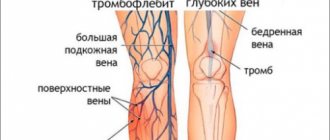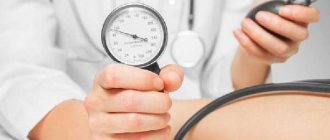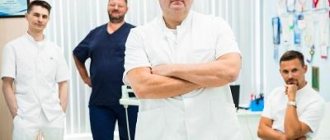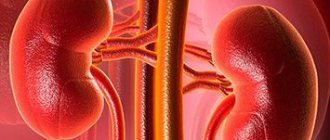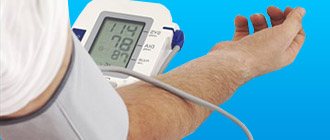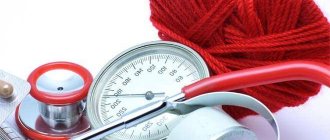Surgeon
Bohyan
Tigran Surenovich
Experience 36 years
Surgeon of the highest category, Doctor of Medical Sciences, member of the International Association of Surgeons, Gastroenterologists and Oncologists
Make an appointment
Varicose veins of the lower extremities are an insidious pathology that can be caused by tight underwear, constant wearing of high-heeled shoes, taking contraceptives, and pregnancy. Visually, varicose veins look like tortuous deformations of the veins on the legs, distinguished by a blue tint, standing out against the background of the skin.
With varicose veins, the venous walls lose their elasticity and firmness due to various factors. Also, the disease can be triggered by a violation of the integrity of the vascular valves, which increases pressure with subsequent stagnation of blood in the subcutaneous vessels and veins.
General information about varicose veins
In this material we will understand what causes the occurrence of dilation of the veins of the lower extremities, what it is, how to effectively get rid of the disorder and restore a beautiful appearance to the legs. According to doctors, the main reason is genetic predisposition. If parents, grandparents had such disorders, their descendants may suffer from this disease. This risk factor cannot be excluded when the disease is diagnosed. It does not matter whether the veins and vessels of the legs or the inguinal vein or anal vessels were dilated. If at least one relative has pathology of the saphenous vein in the lower extremities, sooner or later the descendants may experience symptoms.
Due attention should be paid to prevention, to exclude possible risk factors, then even a weakened leg vein will not be stretched and will not lose elasticity. It is necessary to provide appropriate care to the legs so as not to be affected by any of the factors that cause varicose veins. The main methods of prevention are maintaining an active lifestyle, moderate physical activity, infrequently wearing high heels, and if the slightest symptoms are detected, it is necessary to check with a doctor, because even the slightest problems can cause the development of serious pathology.
Gynecologist who encountered varicose veins
The manifestation of varicose veins can be hidden from the naked eye; very often gynecologists encounter pathology in the area of the pelvic veins (pictured). This pathology can occur during pregnancy, and the gynecologist must diagnose this pathology in a timely manner.
In addition, pelvic varicose veins can cause pain in the lower abdomen; this symptom often brings women to the gynecologist, since external signs are not visible to the naked eye.
Diagnose, cannot treat
Dilated veins in the pelvic area
Gynecologists often encounter varicose veins, but do not treat it, even during pregnancy.
In this case, the gynecologist’s actions are very limited and the instructions for managing the patient are extremely simple:
- order an ultrasound;
- establish a presumptive diagnosis;
- redirect to a more specialized specialist;
- give recommendations on lifestyle (sports, nutrition).
Note! A diagnosis made by a gynecologist is not true without confirmation from a more specialized specialist, so you will definitely have to seek help from a phlebologist.
Symptoms of varicose veins
Varicose veins, which affect the veins of the lower extremities, are classified in international practice by stages, based on the neglect of the pathology and the severity of the manifestation. Each stage is diagnosed separately, all of them are characterized by different symptoms, based on which the treatment method is selected.
So, the symptoms that are a sign of varicose veins at different stages:
- At the first stage, the saphenous veins in the lower extremities have a barely noticeable pattern and protrude slightly above the skin, and slight redness is noticeable. There are complaints to the doctor about heaviness in the legs, evening swelling after a day of work. Swelling in the ankle area can be caused by excessively tight shoes, and cramps are also possible. It should be noted that often painful sensations can appear much earlier than visible signs;
- At the second stage, a typical appearance for diseased veins on the legs is already observed: they are significantly visible above the skin and can be felt with the fingers, looking like knots or beads. As it progresses, the saphenous vein of the lower limb becomes visible and takes on a tortuous shape of a dark blue or even black hue;
- At the third stage, varicose veins become more complicated, signs such as trophic changes in the veins in the legs are observed, the skin becomes dry and pale, daily swelling, and cramps. Symptoms often include a rash on the legs and itchy, itchy skin;
- Symptoms at the fourth, most severe stage are inflammation of the saphenous veins of the lower limb, non-healing trophic ulcers, which are already difficult to treat. The key feature of this stage of disease is the addition of secondary infection and thrombophlebitis. With these manifestations, urgent hospitalization in a hospital and comprehensive use of treatment methods for the whole body are necessary.
Experts identify key risk factors:
- hereditary diseases associated with varicose veins in different parts of the body;
- hormonal disorders can increase blood clotting, decrease the elasticity of the veins in the legs;
- obesity, ascites, which increases the load on the legs, accompanied by dilation of the vein walls;
- pregnancy or lifting heavy objects increases pressure inside the abdominal cavity, which also contributes to weakening of the vascular walls and varicose veins;
- lack of stress on the legs, sedentary work are fraught with dilation of the veins in the legs;
- tight underwear, shoes of a smaller size, which pinches the vein, wearing heels, which causes stagnation of blood circulation in the veins in the legs;
- Varicose veins are often caused by kidney disease or cardiovascular disease, which causes swelling, observed in the dilation of the veins of the lower extremities.
Treatment of varicose veins
EVLC/RFO
- Cost: 72,000 - 112,000 rubles.
- Duration: 40-60 minutes
- Hospitalization: 2-3 hours in hospital
More details
Treatment of varicose veins is primarily aimed at stopping blood flow through the main saphenous veins, in which the valves do not function. This approach allows you to establish the normal functioning of the venous system, and its most effective method is surgical.
Modern minimally invasive methods of treating varicose veins are non-traumatic, less painful and require less recovery time. A real revolution in phlebology was made by such technologies as:
- endovenous laser coagulation (EVLC) - involves the use of thermal energy of laser radiation, does not require incisions and hospitalization of the patient;
- radiofrequency obliteration (RFO) - involves treating the affected vein using waves transmitted by a radiofrequency generator; is considered one of the most painless and safe treatment methods.
EVLT and RFO allow treatment for different degrees of venous insufficiency and wound healing, in the presence of trophic ulcers.
In addition, treatment methods such as:
- compression sclerotherapy, which involves injecting a sclerosant into the affected vein to block it;
- classic phlebectomy, which is performed under spinal anesthesia and involves surgical intervention.
At the CELT clinic, phlebologists prefer to perform painless, bloodless operations that provide an excellent cosmetic effect and do not require long-term recovery. Modern methods of treating varicose veins that we use make it possible to achieve regression of chronic venous insufficiency and stop the development of the disease.
Diagnosis of varicose veins: features and procedures
The main methods that involve the diagnosis of varicose veins of the legs are:
- External examination of varicose veins of the legs, which should be carried out by qualified doctors in a hospital;
- Doppler ultrasound to detect wall compactions in the veins of the lower extremities. Such diagnostics makes it possible to unambiguously determine the stage of the disorder;
- Duplex scanning of the veins in the legs, which is performed by a doctor at a specialized clinic, allows you to clearly identify varicose veins. This method, which combines ultrasound and Doppler examination, can check what is happening with the veins: the speed of blood circulation, the diameter of the leg veins, the functioning of the valves and the condition that characterizes varicose veins;
- A phleboscintigraphic study allows for high-precision analysis and, even at the initial stage, to learn about varicose veins in the legs and take timely preventive measures. It is carried out by introducing a special dye subcutaneously; such liquid in the vein is highlighted on the monitor in a contrasting color;
- Occlusion plethysmography;
- Using tomographic diagnostics of diseases (MRI, computed tomography) it is possible to identify complications accompanying varicose veins;
- Bandage or tourniquet tests for diagnosing diseases are used in combination as an additional method among various methods to determine the stage of varicose veins.
Deciphering the results of diagnosing varicose veins, as a rule, does not require much time. Most procedures take from 10 to 40 minutes, after which the attending physician will announce a diagnosis based on the information received. Diagnostics should be trusted only to an experienced clinic doctor who can make a clear and accurate diagnosis, because treatment at different stages involves different methods, treatment principles, and medications.
Consequences of varicose veins
The consequences of neglected varicose veins are always extremely serious. Firstly, trophic ulcers in varicose veins of the lower extremities are an integral part of the disease in the final stages. Besides the fact that they look very unsightly, they also itch and hurt.
Secondly, all patients diagnosed with varicose veins are at risk of thrombophlebitis of the lower extremities - an inflammatory disease of the veins, in which blood clots form in their lumen. To prevent their appearance, aspirin is also prescribed, but for varicose veins of the lower extremities this is already a double-edged sword. For patients taking anti-clotting drugs, doctors will no longer be able to offer laser surgery as a treatment: while taking aspirin and similar drugs, ablation, the purpose of which is to cause the formation of a blood clot, will simply be useless.
When they ask me: “Doctor, is it possible to live with varicose veins and not do anything about them?”, I honestly answer: “You can live. But you’re unlikely to like such a life!” Firstly, trophic changes in the veins lead to ulcers, which will certainly become infected and leak. Secondly, varicose veins of the superficial veins can lead to deep vein thrombosis of the lower extremities, which is a risk of pulmonary embolism and, in some cases, death.
Artem Viktorovich Chernyakov
Candidate of Medical Sciences, Head of the Surgical Department of City Clinical Hospital No. 15 named after. O.M. Filatova
Doctors treating the disease
Varicose veins in the legs require a qualified, comprehensive approach, and therefore should be carried out in a specialized clinic. For patients who are interested in the question of which doctor treats disorders in the veins of the lower extremities, the answer is clear - this is a phlebologist. A specialist conducts examinations and, based on them, prescribes effective treatment methods or surgical intervention for advanced stages of varicose veins of the legs.
Patients who have become disillusioned with general practitioners need to contact a highly specialized phlebologist with such a disease, who treats the immediate cause of the disease and helps to overcome the disease without serious consequences for the whole body.
Among the many clinics in Moscow where varicose veins are diagnosed, one of the leaders is JSC Meditsina. To undergo examination, diagnosis and take appropriate tests, you need to make an appointment at a clinic where you can choose an experienced doctor who will help you effectively and quickly treat enlarged veins.
The clinic offers research using modern high-precision equipment that allows for color mapping, 3D modeling of tissues and vessels, on which the doctor can examine the veins of the legs in detail, make an accurate diagnosis and prescribe an effective treatment method. In addition to the state in which the veins of the legs are, an analysis of the relief of tissues and vascular walls is also carried out. Thanks to high-precision color images, the doctor gets a clear picture.
Doctors of JSC "Medicine" (clinic of academician Roitberg) with many years of experience help to overcome the underlying causes, symptoms and manifestations of varicose veins, completely get rid of unpleasant painful sensations, regardless of how difficult the condition of the veins of the legs is and how varicose veins proceed. .
Based on symptoms
An ordinary person is unlikely to confidently diagnose himself, so he will initially come to the doctor with complaints. Heaviness or fatigue in your legs may prompt you to visit a therapist, but in reality this is a waste of time. It is much easier to get to a qualified surgeon with these symptoms; this will save a lot of time.
A surgeon is an excellent solution for residents of small towns, since it is extremely difficult to find a highly specialized specialist there.
What should the surgeon do:
- Inspect;
- Listen to complaints;
- Prescribe laboratory and instrumental diagnostics;
- Prescribe treatment or refer it to a specialist;
- Schedule a follow-up appointment if necessary.
Surgeons are non-specialists
Surgeons not only perform operations, but also see patients in the clinic
If the surgeon is competent enough, and the course of varicose veins is not advanced, then there will be no special problems with treatment. If we consider what treatment surgeons recommend in the initial stages, then the price is affordable for anyone.
So, what can the surgeon prescribe:
- Taking anticoagulants;
- The use of venotonic ointments.
- Application of compression.
Treatment methods
For patients who are interested in how to treat varicose veins at different stages, we provide a list of effective techniques and methods to help solve the problem. Treatment, depending on the indications, is divided into non-surgical methods and surgical intervention, which is used if problems with blood vessels and legs have reached their maximum. Treatment is prescribed only after tests and examination have been carried out.
The following non-surgical methods are used in treatment:
- Taking drugs responsible for increasing the tone of the venous walls. Medicines do not remove the causes of the disease, but only prevent the manifestation of a certain symptom, such as heaviness in the legs, swelling. Among the venotonics, Detralex and Phlebodia are the most effective;
- The use of heparin-containing ointments, which also relieve symptoms and help get rid of discomfort (Lioton, Hepatrombin);
- If the patient is at risk of blood clots, prophylaxis is prescribed in the form of taking coagulants;
- Compression hosiery, which reduces the load on the leg, helps distribute stress even during vigorous physical activity, and does not allow blood to stagnate. Thanks to wearing compression stockings or tights, the leg does not feel heavy even at the end of the day, and there is no swelling;
- Elimination of symptoms and causes is possible through preventive measures: stabilization of the daily routine, physical therapy exercises to relieve the stress that occurs on the legs during the day, treatment of associated health disorders.
Indications for the use of surgical treatment of varicose veins are extensive damage to the veins on both extremities, trophic ulcers, thrombophlebitis, phlebothrombosis and other serious conditions that cannot be cured with medication. The choice of treatment for venous disease of the lower extremities with the help of surgery is determined by the specific course of the disease, the presence of concomitant health problems, and other pathologies.
Surgical methods for treating varicose veins are:
- Sclerotherapy - with the help of the procedure, small spider veins can be treated; as a result of gluing, the veins are given integrity. During the procedure, a special adhesive substance is injected into the vessel, which connects the walls with a small degree of damage. After some time, the stars dissolve, minor symptoms disappear, making the legs attractive. The advantage of this method of treatment is the absence of anesthesia and short duration (the procedure lasts 5-15 minutes);
- Laser coagulation - helps to seal larger vessels that are susceptible to wall damage. Treatment is preceded by the administration of local anesthesia. Then the doctor inserts a light guide into the vein, through which the laser beam passes. The radiation heats the venous walls, due to which the vessel is soldered, and the site of adhesion subsequently completely resolves;
- Radiofrequency ablation (coagulation) – doctors have already assessed the effectiveness of this new method in treatment. The essence of the procedure is the action of high-frequency current on the venous walls from the inside, which allows them to stick together;
- Phlebectomy - involves the removal of large vessels, the walls of which will no longer return to a state of tone. Refers to radical methods of treating varicose veins in the legs, in which the veins through which no more than 10% of blood circulation occurs are removed. At the same time, the deep veins are rebuilt to accommodate increased blood volumes. The operation is used for severe subcutaneous veins, nodes and pathologies.
- After treatment in the clinic, certain precautions must be taken. To reduce the load on your legs and achieve maximum results in the treatment of varicose veins, it is recommended to wear flat-soled shoes, not lift heavy objects, and wear compression products prescribed by your doctor.
How to treat varicose veins
Varicose veins on the legs, or simply varicose veins of the legs, are not only an aesthetic, but a serious physical problem for humans in modern society, which directly threatens life and health in the absence of proper therapy. Therefore, phlebology specialists. Vascular surgeons strongly advise that if you have dilated vessels, you should contact a medical facility. There are phlebologists at the MED CITY clinic in the center of Kyiv. With them we will try to understand all the modern methods of treating varicose veins that exist today [1].
According to the latest statistics, in the world more than 75% of women and about 60% of men in developed regions suffer from varicose veins. This means that the pathology of the vascular system has become global and is subject to detailed information to the general population in order to prevent its occurrence in the future.
How do varicose veins occur on the legs?
To have an idea of the reasons for the appearance of dilated veins, let us recall the structure of blood vessels in the lower extremities of a person. The blood in the veins, with each heartbeat, overcomes the laws of physics, moves from bottom to top. This process involves special venous valves that prevent blood from going down. It is the dysfunction of the valves of the venous vessels that provokes the occurrence and further development of varicose veins. There is an inevitable dilation of blood vessels, loss of their tone and an unpleasant aesthetic appearance of the limbs (especially on the legs).
There are several stages of varicose veins, each of which has its own characteristics.
In the first stage, a person does not feel any symptoms, except for minor discomfort in the legs, as well as a feeling of “heavy legs”. Depending on the individual characteristics of the body, fatigue in the legs can occur even after running or walking short distances [2].
The second stage, subcompensatory, is characterized by an increase in the characteristics of the first symptoms, as well as cramps, severe swelling, a tingling sensation or aching discomfort.
At the third stage, the skin on the legs, due to further expansion and deformation of the venous vessels, undergoes irreversible changes, namely:
- compaction of all superficial layers of the skin, as well as the dermis;
- formation of hyperpigmentation on the skin;
- constant swelling, regardless of the time of day;
- the occurrence of trophic ulcers due to an increased level of skin trauma.
Attention! When you reach the third, decompensation stage of varicose veins, you need to consult a doctor to prevent such serious complications of the disease as thromboembolism or thrombophlebitis.
The sooner you come to a qualified specialist in vascular pathologies, the better the prognosis for recovery will be. Depending on the stage of the disease, you must strictly follow all the recommendations of the phlebologist, as well as make adjustments to your lifestyle and give up bad habits.
Cure varicose veins Diagnosis of varicose veins in Kyiv
To determine the stage of development of varicose veins, a primary consultation with a phlebologist is first carried out, during which a face-to-face examination of the patient is carried out, an anamnesis is taken, a survey is carried out regarding the presence of a similar pathology in close relatives, as well as palpation of skin lesions with varicose veins found on the legs. To make an accurate diagnosis, the doctor must offer the patient a special ultrasound examination, called duplex scanning of the vessels of the lower extremities with mapping of blood flow in them. This is a painless procedure, during which the vascular surgeon determines the speed of blood flow and its direction in the vessels.
The medical clinic in Kyiv has installed modern ultrasound equipment, with the help of which it is possible to accurately determine the affected valves in the venous vessels, as well as mark the projection of the vessels on the skin. In the future, this will help to efficiently remove dilated veins during surgical removal of varicose veins [3].
After making an accurate diagnosis, localization, stage of varicose veins, and its morphological assessment, the doctor suggests undergoing treatment, which can be either conservative or surgical, using medical laser systems.
Treatment of varicose veins on the legs using a conservative method
If the stage of the disease is early (first), then the main goal of therapy is to prevent the development of the disease to a more serious extent, as well as to stop the progression of varicose veins. In addition, conservative therapy is used if it is impossible to perform surgical intervention in a patient with varicose veins.
The main components of conservative therapy for varicose veins:
- the use of compression garments, as well as special bandages that have a compressive effect on the skin of the legs, thereby creating a constricting effect on the veins. This method of suppressing varicose veins is not prescribed in the presence of such serious diseases as aortoarteritis or atherosclerosis, in the presence of other inflammatory elements in the lower extremities;
- prescribing individual drug treatment, mainly ointments, with an anticoagulating, anti-inflammatory and tonic effect on the venous vessels. Each such drug has contraindications, so it is necessary to use them with extreme caution during gestation and lactation. In addition, regular measurement of blood clotting levels is an important factor.
The most common methods of treating varicose veins are surgical and laser.
Among them: 1. Venectomy Nowadays, this type of surgical intervention is performed in acute stages of thrombophlebitis, which is accompanied by a special complex structure of the patient’s venous vessels. A phlebologist surgeon ties the trunk of the dilated vein at the point where it flows into the deep veins (that is, crossectomy) and removes the trunk using surgical instruments [4].
The operation is performed under epidural anesthesia or general anesthesia. The duration of the intervention is about one and a half to two hours.
The disadvantages of venectomy are: frequent hematomas at the site of intervention, prolonged pain, the development of neuralgia due to damage to nerve fibers, as well as constant monitoring of physical activity on the affected limb.
2. Minimally invasive laser surgery for varicose veins “MED CITY”
These are low-traumatic methods of surgical interventions, which have replaced traditional venectomy, ensure good tolerance by patients, as well as a minimal likelihood of complications.
Endovasal laser coagulation of varicose veins
With the help of endovasal coagulation (or EVLC), it is possible to treat varicose veins on the legs of any stage, without restrictions on the thickness of the vein trunk. This is possible thanks to the use of the following tools by phlebologist surgeons:
- radial light guides for processing the internal channel of a venous vessel along the entire circumference;
- an automatic pump for filling the areas of the dermis surrounding the vein with an anesthetic, narrowing the vessel, and protecting tissue and muscles;
- a two-wave laser, one of the waves of which is absorbed by hemoglobin, and the second by the vessel wall.
No special preparation is required for endovasal coagulation. A face-to-face consultation with a phlebologist and an ultrasound scan of the veins of the lower extremities is sufficient, as well as a preoperative package of studies, including a coagulogram, general and biochemical blood tests.
During the intervention, the surgeon punctures the venous vessel, then inserts a thin catheter equipped with a light guide, after which it “seals” the vein with a two-wave laser under the control of an ultrasound machine. The duration of the operation is up to 40-50 minutes. A local anesthetic is used to relieve pain. After the procedure, the patient does not need to stay in the hospital hospital, but only wear compression garments for speedy healing of postoperative wounds for about five days.
Miniphlebectomy
A minimally invasive operation during which dilated nodes and their tributaries are removed through punctures from the venous vessels.
Note! Removal of the great and small saphenous veins using phlebectomy is impossible.
Preparation for miniphlebectomy is similar to the previous type of surgery for varicose veins: ultrasound examination of the veins, as well as laboratory tests.
The method has contraindications: the period of gestation and lactation, the presence of thrombophlebitis, infections in the acute phase, blood clotting pathologies, as well as disorders of the musculoskeletal function of the legs.
Miniphlebectomy lasts 40 minutes. After the intervention, wearing compression stockings is indicated.
Sclerotherapy for varicose veins
This technique is non-surgical and allows not only to eliminate varicose veins, but also the vascular network on the skin.
During sclerotherapy, a special preparation is injected into the vein through a puncture, which “glues” the walls of the venous trunk for further resorption of the latter. The MED CITY clinic uses the “foam-foam” technique, or foam sclerotherapy, the main advantage of which is a long stay in the vein and, as a result, increased efficiency. The operation is performed without anesthesia, since the phlebologist uses a very thin insulin needle to administer the active substance.
Contraindications for sclerotherapy for varicose veins are pregnancy and lactation, allergies to the drug, and immunodeficiency.
After sclerotherapy, you need to avoid heavy physical activity, do not visit saunas, do not sunbathe, and wear compression garments.
With the use of modern methods in medicine, varicose veins in our time have ceased to be a death sentence, but just a reason to turn to qualified specialists who will help cope with the dilation of venous vessels. Such doctors are ready to help at the MED CITY clinic in Kyiv.
Cure varicose veins
List of used literature: Varicose veins. National Heart, Lung, and Blood Institute Varicose veins and spider veins. National Women's Health Information Center Varicose veins - Diagnosis and treatment. Mayo Foundation for Medical Education and Research (MFMER) New Treatments for Varicose Veins. WebMD LLC
Indications for varicose veins
The most susceptible to the appearance of varicose veins are people whose professions involve prolonged standing in an upright state, which results in significant stress on the legs. Such professions include hairdressers, salesmen, and surgeons. Also, the reasons lie in overweight and obesity. Varicose veins also occur in women who constantly wear high-heeled shoes.
Varicose veins require the use of certain precautions, indications for prevention, which avoid further development of the disease and help reduce the likelihood of surgical treatment. Such measures include:
- regular examinations in the clinic, it is also necessary to take tests and, if necessary, undergo procedures prescribed by the doctor;
- avoiding prolonged standing, normalizing diet;
- timely treatment measures when such a diagnosis is made;
- use of anti-varicose underwear with varying degrees of compression;
- maintaining a healthy lifestyle, giving up bad habits such as smoking and alcohol;
- It is recommended to add foods that contain large quantities of fiber to the diet;
- timely elimination of constipation.
These measures will help avoid the appearance of varicose veins, and in the first stage they will help remove visible signs, prevent the development of pathology and the appearance of significant vascular nodules.
Contraindications for illness
There are few contraindications for varicose veins, but they must be strictly observed, especially in severe stages of the pathology:
- Passivity and sedentary lifestyle. The purpose of the veins is to return blood through the veins from the extremities to the heart and lungs, this is ensured by the stable functioning of the vascular valves. Varicose veins of the legs occur when blood stagnates in the body. Therefore, physical activity within normal limits is necessary;
- Poor nutrition, consumption of unhealthy foods, since obesity and overweight increase blood pressure;
- Pregnancy, since when carrying a child the load on the limbs increases, the volume of blood in the circulatory system increases;
- Running and intense physical activity. It is recommended to choose sports without excessive stress, yoga, massage, water aerobics;
- Hot shower and bath.
With proper foot care, you can neutralize the signs and causes of the disease, and moderate physical activity will allow your feet to return to their former healthy appearance, because getting sick and treating pathology is much more expensive and difficult than taking preventive measures.
Cost of initial appointment, research, treatment
Prices for treatment at the clinic of JSC "Medicine" are listed on the official website for your information. To clarify the current cost of treatment, you need to sign up for an initial consultation, at which the doctor will carry out diagnostic measures, identify the features of the disorder, and prescribe treatment using modern techniques.
The price of treatment in a medical clinic directly depends on diagnostic and treatment methods, however, in each specific case of varicose veins of the legs, the most effective treatment measures are prescribed. In advanced stages, it is expensive to treat the disorder, but only with the help of surgical interventions followed by a hospital stay can aggravated manifestations be resolved. The clinic offers only innovative technologies, detailed analysis and comfortable conditions.
The cost of the analysis varies, depending on the complexity. Innovative approaches to treatment are offered, while prices remain affordable. The price of tests is determined based on the complexity of the case.
How is the treatment carried out?
Before you see a doctor, decide whether you want to know the diagnosis or be treated. Based on the diagnostic results, even a student can confirm the diagnosis of varicose veins, but it must be treated by a professional.
Surgical treatment is carried out by an angiosurgeon (vascular surgeon), and contacting him will be logical only after a referral from a phlebologist.
What are the responsibilities of an angiosurgeon:
- examination of the patient;
- clarification of the patient’s chronic diseases;
- determining the possibility and necessity of surgical intervention;
- recommendations on the type of operation;
- performing surgical treatment;
- observation in early postoperative treatment;
- recommendations for the postoperative recovery period.
Often the operation is not as scary as it seems
If you have received confirmation of the diagnosis, but do not know which doctor to contact with varicose veins specifically for consultation on the operation, then contacting an angiosurgeon is the most logical of all possible solutions.
Note! Most often, the angiosurgeon needs confirmation of the diagnosis from a phlebologist, so it is not always possible to get to the doctor directly.
Advantages of treatment at the clinic of JSC "Medicine"
The Clinic of JSC "Medicine" is a multidisciplinary medical center that offers a range of services, including surgery and hospital stay.
Treatment of varicose veins in the legs at JSC "Medicine" (clinic of Academician Roitberg) has the following advantages:
- availability of a license to conduct medical activities, receive patients, perform surgical operations;
- each doctor has appropriate qualifications and extensive experience, and their achievements are posted on the medical center’s website;
- high-tech innovative equipment for conducting analyzes and research to establish the true causes of health problems;
- cooperation with insurance companies, loyalty programs for corporate clients.
Doctors conduct a thorough and in-depth analysis of a person’s health status, identify the underlying causes that led to the appearance of varicose veins in the legs, and prescribe effective methods in an outpatient or inpatient setting.
